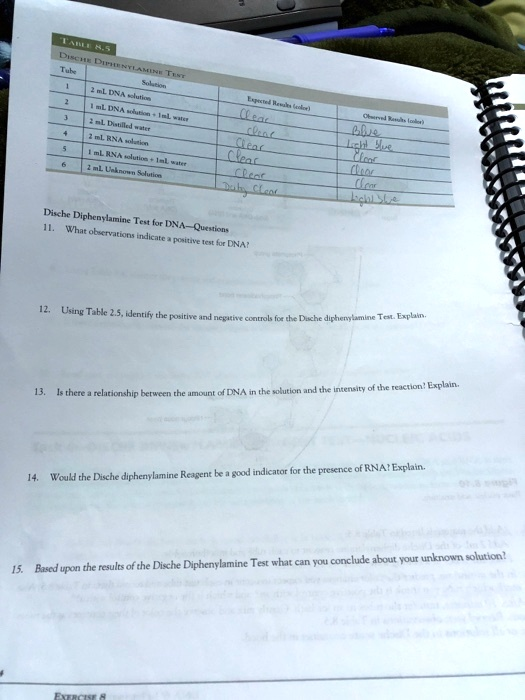DISCHE DIPHENYLAMINE TEST Tube Solution Expected Results (color) Observed Results (color) 1 2 mL DNA solution Clear Blue 2 1 mL DNA solution + 1 mL water Clear Light Blue 3 2 mL Distilled water Clear Clear 4 2 mL RNA solution Clear Clear 5 1 mL RNA solution + 1 mL water Clear Clear 6 2 mL Unknown Solution Dirty Clear Light Blue Dische Diphenylamine Test for DNA-Questions 11. What observations indicate a positive test for DNA? 12. Using Table 2.5, identify the positive and negative controls for the Dische diphenylamine Test. Explain. 13. Is there a relationship between the amount of DNA in the solution and the intensity of the reaction? Explain. 14. Would the Dische diphenylamine Reagent be a good indicator for the presence of RNA? Explain. 15. Based upon the results of the Dische Diphenylamine Test what can you conclude about your unknown solution? EXERCISE 8

The Correct Answer and Explanation is:
11. A positive test for DNA is indicated by a blue or light blue color change. In the table, Tubes 1 and 2 show this change, demonstrating the presence of DNA.
12. The positive control is Tube 1 (2 mL DNA solution) because it is expected to give a known positive result (blue color), confirming the test works properly. The negative controls are Tubes 3, 4, and 5. Tube 3 contains distilled water, while Tubes 4 and 5 contain RNA. All these yield a clear result, indicating no DNA present and showing the test does not give false positives.
13. Yes, there is a direct relationship between DNA concentration and the intensity of the blue color. Tube 1, with full-strength DNA, appears blue, while Tube 2, with diluted DNA, appears light blue. This suggests the test is semiquantitative, where a stronger blue indicates a higher concentration of DNA.
14. The Dische Diphenylamine reagent is not a good indicator for RNA. RNA samples (Tubes 4 and 5) remained clear, showing no reaction. This makes the test specific to DNA, particularly to deoxyribose sugar, which undergoes dehydration to form a compound that reacts with diphenylamine.
15. The unknown solution in Tube 6 shows a light blue color, similar to that in Tube 2. This indicates the presence of DNA, likely in a diluted concentration. Since RNA solutions remained clear and did not give this color change, we can conclude that the unknown contains DNA, not RNA.
Explanation: The Dische Diphenylamine Test is a classic biochemical assay for detecting DNA, relying on the reaction between deoxyribose sugars and diphenylamine under acidic conditions. The development of a blue color signifies a positive reaction due to the formation of a colored compound. The test is highly specific to DNA, which contains deoxyribose, and does not react with RNA, which contains ribose. Control tubes are critical for validating the accuracy of any test. A positive control confirms the reagents and conditions are functioning, while negative controls rule out nonspecific interactions. In this experiment, the differences in color intensity helped estimate relative DNA concentration. Tube 6’s light blue result aligns well with diluted DNA, suggesting the unknown sample contains DNA at a similar or slightly lower concentration than Tube 2. This reinforces the utility of the test in distinguishing DNA from RNA and assessing relative abundance.
